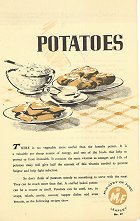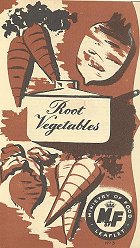Bedfordshire
The Home Front
Places > Bedfordshire > Second World War
The 'Kitchen' Front
Preparations for the distribution of food began in 1936 when the Food (Defence Plans) Department of the Board of Trade was set up. Work continued over the next two years and in September 1938 the (London) Times announced that 50,000,000 ration cards were ready for distribution.
Rationing was eventually introduced in January 1940. The first provisions to be rationed were sugar, butter, ham and bacon; these were soon followed by meat, tea, margarine, cheese and eggs. The Bedfordshire Times (5th January 1940) noted that over 54,000 ration books were issued from the Bedford Food Office and that there were 262,358 registrations for bacon and ham, 266,669 for butter and 270,787 for sugar.
To help people make their food ration go further information leaflets were issued by the Ministry of food. These tried to encourage people to make the best of their food rations and augment them with unrationed foods such as potatoes, flour, oatmeal and vegetables.
Click the images to see larger versions
Potatoes were a particularly important war food and their value was promoted by 'Potato Pete'. 'Potato Pete' had his own song which was tremendously successful in getting the message across. At the beginning of the war Bedfordshire had 10,100 acres of land in potato production but because the government placed such importance on the crop Bedfordshire farmers were soon asked to increase acreage by the Ministry (Bedfordshire Times 20th December 1940).
Throughout the war people were also encouraged to "Dig for Victory" by producing their own vegetables and turning their gardens into mini-allotments. Even school children joined in. Head Teachers of Bedfordshire schools produced 1,333 worth of vegetables in 1944 to help supply the school canteens, an effort that was praised by the education department of the day (Bedfordshire Times 11th February 1944).
As well as rationing the prices of some foods were also controlled by the Ministry of Food. For example, the Bedfordshire Times informed housewives in May 1940 that they should not pay more than 1s. 4d. per 1b for Farmhouse Cheddar or 1s. 3d. per 1b. for Cheshire, Lancashire or Leicestershire cheese. With their cheese ration they could make all manner of recipes including the following 'Parsnip and cheese fritters' (serves four).
1lb. parsnips
4 oz. plain flour
1 dried egg, dry
2-3 oz. grated cheese
Salt and pepper
1/3rd pint milk
1 level teaspoon of baking powder
Fat for frying
"Cook the parsnips in salt water until tender. Drain and cut into thick slices. Make the batter by mixing the dry ingredients together, then adding the milk to make a stiff batter. Beat well. Just before mixing add the baking powder. Dip the parsnips into the batter and fry in the smoking hot fat till golden brown." (Ministry of Food Leaflet No.3)
The hardships of "the kitchen front" continued long after the war had ended and indeed became worse before they became better, for example in July 1946 bread was put on ration causing uproar. It was not until 2nd July 1954 that rationing finally ended with the de-restriction of meat, a period of some fourteen years in total.
Sources:
- Bedfordshire Times Newspaper
- Ministry of Food leaflets (No.1 Green vegetables, No.3 Root vegetables, No. 27 Potatoes
- Times Digital Archive
- Victory cookbook: nostalgic food and facts from 1940-1954 by Marguerite Patten OBE
Page last updated: 4th February 2014



